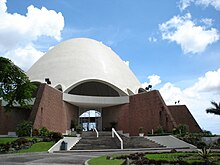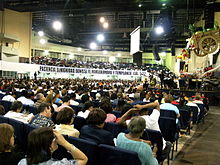Religion in Panama
| Religion in Panama (2020) Pew Research Center |
|---|
| Catolicism 72.7% Protestantism 20% irreligion 5% Other religions 2.3% |
Religion in Panama is protected by the Political Constitution of the Republic of Panama, which establishes freedom of worship. Although with some reservations, the government generally respects this right.
The Panamanian government does not collect statistics on citizens' religious affiliations; but, various sources estimate that 85 percent of the population identifies as Catholic and 7 percent as Evangelical Christian. Panama is the Central American country with the most adherents to Catholicism, in addition the nation is viewed religiously as a country with great diversity of religion, with a minimum percentage of atheists.
The Baha'ist community in Panama comprises 2% of the national population with some 60,000 members, including about 10% of the Ngäbe population; the Baha'is maintain one of the seven Houses of Worship in Panama Bahá'í of the world. The Church of Jesus Christ of Latter-day Saints, also known as Mormons, has about 40,000 members in the country. Among the religious groups with the fewest adherents, we have Seventh-day Adventists Today, Jehovah's Witnesses, Episcopalians who have between 7,000 and 10,000 members, Jewish and Muslim communities, with approximately 10,000 members each, Hindus, Buddhists, and other Christians. Among the indigenous religions we have the Ibeorgun, of the Guna people, and Mama Tatda, among the Ngäbe. Also, we can find isolated nuclei of the Rastafari community.
Christianity
Catholicism
Introduced by the Castilians, Catholicism is the main religion of the country. Catholics are found throughout the country and at all social levels.
Protestantism
The next group in percentage importance is that of Protestant Christians, who are also found throughout the national territory and have a high rate of growth in the country. The main Protestant groups include evangelical Pentecostal churches such as the Assemblies of God, The Foursquare Church, plus the Southern Baptist Convention and other Independent Baptist churches, the United Methodist Church, the Methodist Church of the Caribbean and the Americas, and the Lutheran Church, which is practiced by the people of the Antilles and the communities of expatriates, which are concentrated in the provinces of Panama and Colón. The Church of God Ministerial of Jesus Christ International is also present.
Mormons
In its seventy-five years of presence in Panama, since the arrival of the first Mormons with the construction of the Panama Canal, the country currently has some 59,526 members, more than 73 congregations, a Temple, more than 200 missionaries from 18 nations serving in Panama preaching the gospel and serving others and 170 young Panamanians serving as missionaries for the Church in 17 countries around the world.
Judaism
Although crypto-Jews from the Iberian Peninsula have lived in Panama since the early XVI century, there was no Established Jewish community openly practicing their religion probably as late as the 19th century. Jews, both Sephardim and Ashkenazis, began to emigrate to Panama in significant numbers in the mid-XIX century, attracted by economic incentives such as such as the construction of the Bi-Oceanic Railroad and the California Gold Rush. Other major waves of migration occurred during World War I, the breakup of the Ottoman Empire, before and after World War II from Europe, expulsion from Muslim countries in 1948, and more recently from South American countries that suffered economic crises. Approximately 10,000 Jews live in Panama. Currently, the vibrant Jewish community is concentrated in Panama City, and is fully integrated into Panamanian society. Unlike other countries, Panamanian Jews are actively involved in commerce, government, civic and diplomatic functions. Outside of Israel, Panama is the only country in the world to have had two Jewish presidents in the XX: Mr. Max DelValle and Mr. Eric Arturo Delvalle.
Baha'iism
The history of the Bahá'í Faith in Panama begins with a mention of 'Abdu'l-Bahá, then head of the Bahá'í Faith, in the book Tablets of the Divine Plan, published in 1919. The same year, Martha Root, a leading Bahá'í instructor, made a voyage around South America, including Panama on the return trip up the west coast, passing through the provinces of Panama and Colon.
The first Bahá'í pioneers began settling in Panama in 1940. The first Bahá'í Local Spiritual Assembly of Panama, in Panama City, was elected in 1946, and the National Spiritual Assembly was elected for the first time in 1961. Later, in 1972, the Bahá'ís of Panama inaugurated a Bahá'í House of Worship located on the top of Cerro Sonsonate. The design of this temple was in charge of the British architect Peter Tillotson, his proposal being the one chosen from among some 72 proposals.
In 1983 and again in 1992, some Bahá'í commemorative stamps were produced in Panama, while the community turned its interests to the San Miguelito and Chiriquí regions, with schools and a radio station. The Association of Religion Data Archives estimated that there were about 41,000 Bahá'ís in 2005, while other sources put it closer to 60,000.
Hinduism
Hinduism came to Panama through Indian immigration. It began at the time of the construction of the canal, around the year 1850. The Hindu community, in general, has adapted well to the life and customs of Panama.
Traditional Hinduism
Hindus have a Hindu Temple in Panama City. The temple was built in 1987, commissioned by businessman Mohan H. Mayani. Its design was in charge of the architect Oscar Azar. This temple is, in turn, a tourist attraction in Panama City.
ISKCON
The International Association for Krisna Consciousness is a new Gaudía Vaisnavist Hindu religious movement. The "hare krishna", as they are commonly known, have a small temple in Villa Zaíta, Las Cumbres. Since 2005, the ISKCON faithful have held a local version of the Ratha yatra festival in Panama City.
Neopaganism
A small number of Neopagans, and some Traditional Wiccan Covens, operate in Panama, as well as many solitary practitioners of Eclectic Wicca, as well as organized groups affiliated with the International Pagan Federation. There are nine Wiccan Covens affiliated with the International Pagan Federation. Alliance of Hispanic American Wicca, which is installed in 7 Latin American countries, including Panama and its representative is the Coven Panama 322 of Traditional Hispanic American Wicca and Algard, also affiliated with the International Pagan Federation: which has a low social acceptance at the national level due to their practices.
Indigenous spirituality
The indigenous peoples of Panama also have indigenous spiritual beliefs; Mainly animistic. In general, these are not formally organized as religions, but are part of the culture and lifestyle of these peoples.
Mama Tatdä
The Mamä Tatdä religion is a new syncretistic religious movement started in 1962 by Besikö Kruningrobu, a Ngäbe woman also known as "Mamä Chi". According to its own practitioners, the religion has more than 200,000 believers.
Other religions
There are also groups of Buddhists, Sikhs, and Rastafarians in the country.
Islamic
Islam has important populations in the capital city and in the city of Colón. Some minority Muslim groups can also be found in San José de David as well as in other provincial cities. The vast majority of Muslims are of Lebanese, Palestinian or Indian origin.
Buddhism
School of the True Buddha
The True Buddha School is a new religious movement of Vajrayāna Buddhist character. Since 1996, the Buddhists of this current formed the Buddhist Association of Panama and, in 2006, inaugurated the Chang Hung Buddhist Temple, located on the Trans-Isthmian Highway, between the limits of the townships of Bella Vista and Bethania, Panama City.
Soka Gakkai
The Soka Gakkai, an organization aligned with the Nichiren school of Buddhism, has existed in Panama since 1968.
Tibetan Buddhism
The Karma Kagyu school of Tibetan Buddhism, itself a Vajrayāna school, has a small Camino del Diamante center in Coco del Mar, a town in the township of San Francisco, Panama City.
Sikhism
The Sikhs of Panama come mainly from the Sindh region of Pakistan and the Punjab region located between Pakistan and India. The Sikhs have a gurdwara, the Gurdwara Guru Nanak Sahib, which was inaugurated in 1986 and is located in the district of Parque Lefevre, Panama City.
Rastafarian Movement
The first contact between Panama and what could be considered the Rastafarian proto-movement occurs in the early years of the Republican era and has a close link with Afro-Panamanianity. Around 1911, after his expulsion from Costa Rica, Marcus Garvey, an influential figure for the movement despite his distance from and disagreement with it, had his first contact with Panama, where he visited Bocas del Toro and Colón and learned about the working conditions of those of African descent. During this trip, he came to work in Colón as a journalist for a bilingual biweekly called La Prensa (not related to the newspaper founded in the 1980s under the same name). At this same time, a young Leonard Howell, who would later become the pioneer of the Rastafarian movement itself, would work as a sailor, traveling between New York City and Panama. During these travels, Howell would join the Universal Negro Development Association and Garvey's League of African Communities in New York, before having a temporary stay in Colón, Panama in 1918. Due to these events and his perceived influence on the eventual formation of the Rastafari Movement, Rasta Nini, a member of the Rastafari community and who was also a pioneer of Reggae in Spanish, assures that "Panama should be considered the cradle of Rasta, the Rastafari Movement and black culture".
In the early 2000s, Panamanian Rastafarians founded the Panamanian Rastafari Alliance. Panama also hosted, in 2005, the First Hispanic-American Rastafari Summit.
Most of the Rastafarians in Panama belong to the Nyabinghi order, although there are also Bobo Shantis.
Freedom of worship
The government of the United States of America stated that there were no reports of abuse or discrimination based on religious belief or practice in 2007.
Contenido relacionado
George Simmel
Neoludism
Abbey





